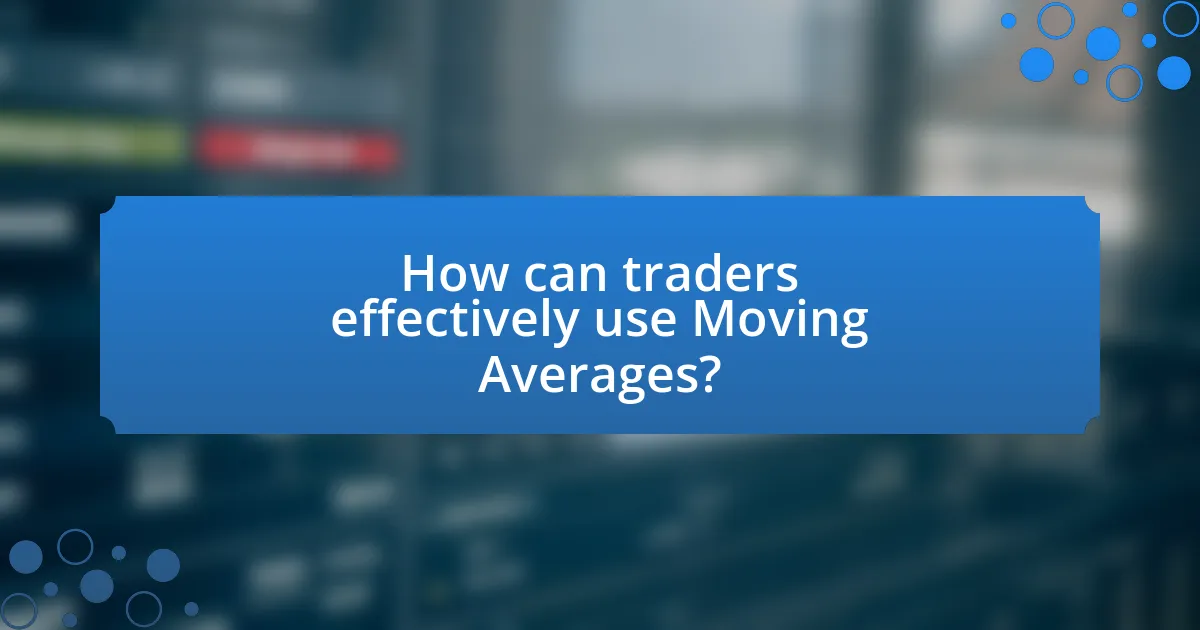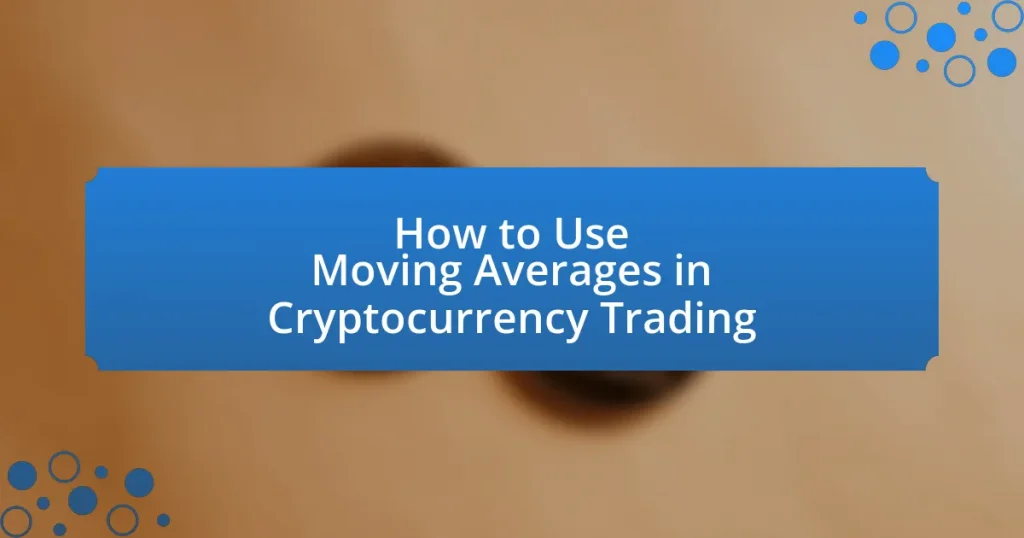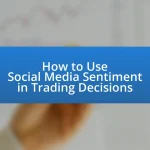Moving averages are essential statistical tools in cryptocurrency trading, used to analyze price trends and identify market directions. This article explores the different types of moving averages, including Simple Moving Averages (SMA) and Exponential Moving Averages (EMA), and their functions in smoothing price data to generate buy and sell signals. It discusses the significance of moving averages in identifying entry and exit points, strategies for effective use, and best practices to enhance trading decisions. Additionally, the article addresses the limitations of relying solely on moving averages and offers insights on how to mitigate false signals and optimize their application in various market conditions.

What are Moving Averages in Cryptocurrency Trading?
Moving averages in cryptocurrency trading are statistical calculations used to analyze price trends over a specific period. They smooth out price data to create a trend-following indicator, which helps traders identify the direction of the market. For instance, the simple moving average (SMA) calculates the average price over a set number of periods, while the exponential moving average (EMA) gives more weight to recent prices, making it more responsive to new information. These tools are widely used in technical analysis to generate buy and sell signals, as they can indicate potential reversals or continuations in price trends.
How do Moving Averages function in the context of cryptocurrency?
Moving averages function in cryptocurrency by smoothing price data to identify trends over a specific period. They help traders determine the direction of the market by filtering out short-term price fluctuations, allowing for clearer signals regarding potential buy or sell opportunities. For instance, a commonly used moving average is the 50-day moving average, which calculates the average price of a cryptocurrency over the last 50 days. When the current price crosses above this average, it may indicate a bullish trend, while a cross below could suggest a bearish trend. Historical data shows that traders often rely on moving averages to make informed decisions, as they can highlight significant support and resistance levels in volatile markets.
What are the different types of Moving Averages used in trading?
The different types of Moving Averages used in trading are Simple Moving Average (SMA), Exponential Moving Average (EMA), and Weighted Moving Average (WMA). The Simple Moving Average calculates the average price over a specified number of periods, providing a straightforward view of price trends. The Exponential Moving Average gives more weight to recent prices, making it more responsive to new information, which is particularly useful in volatile markets like cryptocurrency. The Weighted Moving Average assigns different weights to prices, allowing traders to emphasize certain periods more than others. These moving averages are essential tools for traders to identify trends and make informed decisions based on historical price data.
How do Simple Moving Averages differ from Exponential Moving Averages?
Simple Moving Averages (SMA) differ from Exponential Moving Averages (EMA) primarily in their calculation methods and responsiveness to price changes. SMA calculates the average price over a specified number of periods, giving equal weight to each price point, while EMA applies more weight to recent prices, making it more sensitive to recent price movements. This difference in weighting means that EMA reacts faster to price changes compared to SMA, which can be beneficial in volatile markets like cryptocurrency trading. For example, during rapid price fluctuations, an EMA can signal trends more quickly than an SMA, allowing traders to make timely decisions.
Why are Moving Averages important for cryptocurrency traders?
Moving averages are important for cryptocurrency traders because they help identify trends and potential reversal points in price movements. By smoothing out price data over a specific period, moving averages provide a clearer picture of the market direction, allowing traders to make informed decisions. For instance, the 50-day and 200-day moving averages are commonly used to determine bullish or bearish trends; when the short-term average crosses above the long-term average, it signals a potential upward trend, known as a “golden cross.” Conversely, a “death cross” occurs when the short-term average crosses below the long-term average, indicating a potential downward trend. Historical data shows that traders who utilize moving averages can enhance their trading strategies, as these indicators have been shown to correlate with price movements in various market conditions.
What insights can Moving Averages provide about market trends?
Moving Averages provide insights into market trends by smoothing price data to identify the direction of the trend over a specific period. They help traders recognize bullish or bearish trends by indicating whether prices are above or below the moving average line. For instance, when the price crosses above a moving average, it often signals a potential upward trend, while a cross below may indicate a downward trend. Historical data shows that traders frequently use the 50-day and 200-day moving averages to assess long-term trends, with crossovers between these averages often serving as buy or sell signals.
How do Moving Averages help in identifying entry and exit points?
Moving averages assist in identifying entry and exit points by smoothing price data to highlight trends over a specific period. Traders often use the crossover of short-term and long-term moving averages as signals; for instance, when a short-term moving average crosses above a long-term moving average, it indicates a potential buying opportunity (entry point), while a crossover below suggests a selling opportunity (exit point). Historical data supports this method, as studies show that moving average crossovers can effectively predict price movements in various markets, including cryptocurrency, enhancing decision-making for traders.

How can traders effectively use Moving Averages?
Traders can effectively use Moving Averages by employing them as indicators for trend direction and potential entry or exit points. Moving Averages smooth out price data to identify trends over specific periods, allowing traders to make informed decisions based on historical price movements. For instance, a common strategy involves using the crossover of a short-term Moving Average, such as the 50-day, with a long-term Moving Average, like the 200-day, to signal potential buy or sell opportunities. When the short-term Moving Average crosses above the long-term Moving Average, it indicates a bullish trend, while a crossover below suggests a bearish trend. This method is supported by historical data showing that Moving Average crossovers have been effective in predicting price movements in various markets, including cryptocurrencies.
What strategies can be employed with Moving Averages in trading?
Moving averages can be employed in trading through several strategies, including the crossover strategy, trend identification, and support/resistance levels. The crossover strategy involves using two moving averages, typically a short-term and a long-term, where a buy signal is generated when the short-term moving average crosses above the long-term moving average, and a sell signal occurs when it crosses below. This method is supported by the fact that historical data shows that such crossovers can indicate potential price reversals or continuations.
Trend identification utilizes moving averages to determine the overall market direction. When the price is above a moving average, it indicates an uptrend, while a price below suggests a downtrend. This strategy is validated by the observation that many traders rely on moving averages to confirm trends, as they smooth out price fluctuations and provide clearer signals.
Additionally, moving averages can act as dynamic support and resistance levels. Traders often look for price reactions at these moving averages, as they can serve as areas where the price may bounce or reverse. This is evidenced by the frequent occurrence of price consolidations around moving averages in historical price charts, indicating their significance in trading decisions.
How can traders combine Moving Averages with other indicators?
Traders can combine Moving Averages with other indicators by using them to confirm trends and signals. For instance, traders often pair Moving Averages with the Relative Strength Index (RSI) to identify overbought or oversold conditions while confirming trend direction. When the price is above a Moving Average and the RSI indicates overbought conditions, it may signal a potential reversal. Additionally, traders may use Moving Averages alongside Bollinger Bands to assess volatility; when the price touches the upper band while above a Moving Average, it may indicate a strong bullish trend. This combination enhances decision-making by providing multiple layers of analysis, thereby increasing the reliability of trading signals.
What is the significance of the crossover strategy in Moving Averages?
The significance of the crossover strategy in Moving Averages lies in its ability to signal potential changes in market trends. When a shorter-term moving average crosses above a longer-term moving average, it indicates a bullish trend, suggesting that traders may consider entering a long position. Conversely, when the shorter-term moving average crosses below the longer-term moving average, it signals a bearish trend, prompting traders to consider exiting positions or entering short positions. This strategy is widely used due to its simplicity and effectiveness in identifying trend reversals, supported by historical data showing that crossovers often precede significant price movements in various markets, including cryptocurrency.
How can traders avoid common pitfalls when using Moving Averages?
Traders can avoid common pitfalls when using Moving Averages by ensuring they select the appropriate time frame for their trading strategy. Using a time frame that aligns with their trading style—such as short-term for day trading or longer-term for swing trading—helps in accurately capturing market trends. Additionally, traders should avoid relying solely on Moving Averages without considering other indicators, as this can lead to false signals; for instance, combining Moving Averages with volume analysis or momentum indicators can provide a more comprehensive market view. Furthermore, traders must be cautious of whipsaw effects during volatile market conditions, which can mislead them into making premature trades. By implementing these strategies, traders can enhance their decision-making process and reduce the likelihood of losses associated with Moving Average usage.
What are the limitations of relying solely on Moving Averages?
Relying solely on Moving Averages has significant limitations, primarily their lagging nature, which can result in delayed signals for traders. This delay occurs because Moving Averages are based on past price data, making them less effective in rapidly changing market conditions. Additionally, they can produce false signals during periods of high volatility, leading to potential losses. For instance, in a sideways market, Moving Averages may generate multiple buy and sell signals that do not correspond to actual price movements, causing confusion for traders. Furthermore, they do not account for fundamental factors or news events that can impact prices, limiting their effectiveness as standalone indicators in cryptocurrency trading.
How can false signals from Moving Averages be mitigated?
False signals from Moving Averages can be mitigated by using multiple time frames for analysis. By examining Moving Averages across different time frames, traders can confirm trends and reduce the likelihood of acting on misleading signals. For instance, a short-term Moving Average may indicate a buy signal, but if the long-term Moving Average shows a downtrend, the trader can avoid entering a position based on the false signal. Additionally, incorporating other technical indicators, such as Relative Strength Index (RSI) or MACD, can provide further confirmation of trends and help filter out false signals. This multi-faceted approach enhances the reliability of trading decisions based on Moving Averages.

What are the best practices for using Moving Averages in cryptocurrency trading?
The best practices for using Moving Averages in cryptocurrency trading include selecting appropriate timeframes, using multiple Moving Averages for confirmation, and incorporating them with other technical indicators. Selecting timeframes such as the 50-day and 200-day Moving Averages helps traders identify both short-term and long-term trends effectively. Utilizing multiple Moving Averages, like the crossover strategy where a short-term Moving Average crosses above a long-term Moving Average, can signal potential buy or sell opportunities. Additionally, combining Moving Averages with other indicators, such as Relative Strength Index (RSI) or MACD, enhances decision-making by providing further confirmation of market trends. These practices are supported by historical data showing that traders who apply these strategies often achieve better risk management and improved entry and exit points in volatile markets like cryptocurrencies.
How can traders optimize their use of Moving Averages?
Traders can optimize their use of Moving Averages by selecting the appropriate type and period of the Moving Average to match their trading strategy. For instance, short-term traders may benefit from using a 10-day or 20-day Moving Average to capture quick price movements, while long-term investors might prefer a 50-day or 200-day Moving Average to identify broader trends.
Additionally, traders can enhance their effectiveness by combining Moving Averages with other technical indicators, such as the Relative Strength Index (RSI) or MACD, to confirm signals and reduce false positives. Historical data shows that using a combination of a short-term and a long-term Moving Average, known as a Moving Average crossover strategy, can effectively signal entry and exit points, as evidenced by studies indicating that this method can yield higher returns in various market conditions.
What timeframes are most effective for different trading styles?
Scalpers typically find the 1-minute to 5-minute timeframes most effective, as they require quick trades to capitalize on small price movements. Day traders often prefer 15-minute to 1-hour timeframes, allowing them to capture intraday trends without holding positions overnight. Swing traders generally utilize 4-hour to daily timeframes, focusing on capturing larger price swings over several days or weeks. Position traders, on the other hand, benefit from daily to weekly timeframes, as they aim for long-term trends and are less concerned with short-term volatility. These timeframes align with the trading styles’ objectives, enabling traders to make informed decisions based on their strategies.
How often should traders adjust their Moving Average settings?
Traders should adjust their Moving Average settings as market conditions change, typically on a weekly or monthly basis. This frequency allows traders to respond to shifts in volatility and trends, ensuring that their Moving Averages remain relevant to current price action. For instance, during periods of high volatility, traders may find it beneficial to shorten the Moving Average period to capture rapid price movements, while in stable conditions, longer periods may provide better signals. Adjusting settings based on market analysis and performance metrics can enhance trading effectiveness and accuracy.
What tips can enhance the effectiveness of Moving Averages in trading?
To enhance the effectiveness of Moving Averages in trading, traders should consider using multiple time frames for analysis. This approach allows traders to identify trends more accurately by comparing short-term and long-term Moving Averages, which can signal potential buy or sell opportunities. For instance, when a short-term Moving Average crosses above a long-term Moving Average, it often indicates a bullish trend, while the opposite crossover can signal a bearish trend. Additionally, incorporating volume analysis alongside Moving Averages can provide further confirmation of trends, as higher trading volumes during a crossover can validate the strength of the signal. Historical data supports this method, as studies have shown that traders using multiple time frames can achieve higher success rates in predicting market movements.
How can backtesting improve the application of Moving Averages?
Backtesting can significantly enhance the application of Moving Averages by allowing traders to evaluate the effectiveness of their strategies against historical data. This process involves simulating trades using past price movements to determine how well a specific Moving Average strategy would have performed. For instance, a study by the CFA Institute found that backtesting can improve trading strategies by providing insights into potential profitability and risk management, enabling traders to refine their approach based on empirical evidence. By analyzing metrics such as win rates and drawdowns during backtesting, traders can make informed adjustments to their Moving Average parameters, ultimately leading to more effective trading decisions in the cryptocurrency market.
What role does market volatility play in using Moving Averages?
Market volatility significantly influences the effectiveness of Moving Averages in trading strategies. In highly volatile markets, Moving Averages may produce false signals due to rapid price fluctuations, leading to potential losses. For instance, during periods of high volatility, short-term Moving Averages can react quickly to price changes, which may result in whipsaw effects, where traders are misled into making trades that do not align with the overall trend. Conversely, in stable markets, Moving Averages can provide clearer signals, as price movements are more predictable and less erratic. Historical data shows that during the 2020 cryptocurrency market surge, traders relying on Moving Averages experienced varying degrees of success, highlighting the importance of considering market volatility when applying this tool.


